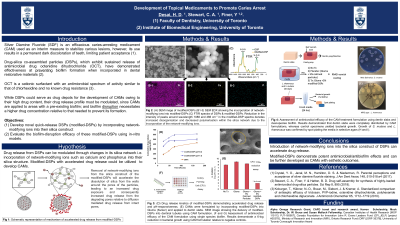Caries
56 - Development of Topical Medicaments to Promote Caries Arrest

- HD
Hetal Desai, DDS, MS
Pediatric dentistry resident/PhD candidate
University of Toronto
University of Toronto
Toronto, Ontario, Canada - CS
Cameron A. Stewart, PhD (he/him/his)
Postdoctoral Fellow
University of Toronto
University of Toronto - YF
Yoav Finer, DMD, PhD, FRCDC
Professor
University of Toronto
Toronto, Ontario, Canada - JO
Jill Oxner, BSc (Hons), DDS, MSc, Pediatric Dentistry, FRCD(C)
Assistant Professor
University of Toronto
Toronto, Ontario, Canada
Presenting Author(s)
Co-Author(s)
Research Mentor(s)
Program Director(s)
Purpose: Silver Diamine Fluoride is an efficacious caries-arresting medicament (CAM), however, its use results in a permanent dark discoloration of treated teeth. We previously engineered antimicrobial drug-silica co-assembled particles (DSPs), to prevent biofilm formation in dental restorative materials, using octenidine dihydrochloride (OCT) as pore-templating drug. Our aim is to accelerate drug release from DSPs by incorporating network-modifying ions into their silica construct to facilitate the disruption of a pre-exiting biofilm, and apply these modified-DSPs to develop effective CAMs.
Methods: Modified-DSPs were synthesized using Ca2+ /PO4- as network-modifying ions in a one-pot synthesis approach. Particles were characterized and the drug release kinetics were measured. CAMs were formulated by incorporating modified-DSPs into Gluma (Kulzer) and their biofilm-disruption ability was evaluated by performing Colony forming unit (CFU) assay using Calgary Biofilm Device. Sterilized dentin slabs were infected with S. mutans and L. rhamnosus for 10 days. CAMs were applied to dentin slabs and coated with varnish. After 24 hrs, dentin samples were collected using sterile burs and incubated in media to assess bacterial viability.
Results: Modified-DSPs demonstrated a higher drug release relative to DSPs up to 72 hrs and pH-responsiveness. CFU assay demonstrated a 6-log reduction in bacterial growth in treatment groups relative to controls. Dentinal tubules were completely disinfected by CAM formulations, whereas control specimens yielded bacterial growth from bur samples.
Conclusions: The drug release from DSPs can be accelerated by making changes to its inorganic phase. Modified-DSPs demonstrate potent antimicrobial effects, and can be further developed as CAMs.
Identify Supporting Agency and Grant Number: Research Supported by Alpha Omega research grant

.jpg)